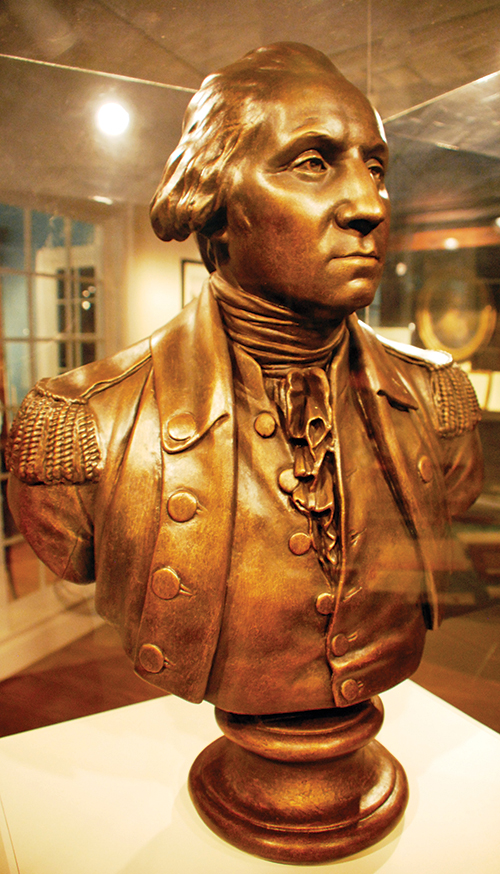
Alabama is home to 2nd largest collection of Washington memorabilia
Story and photos by Emmett Burnett
Here’s something you probably don’t know about George Washington: He was buried twice.
Our first president’s interment was in 1799 but in 1831 he was exhumed from the badly deteriorating family vault and moved to a better-constructed brick enclosure. Here’s something else you don’t know: His casket liner was cut into sections and sold as souvenir pieces. One of those pieces is in Columbiana, Alabama.
The casket remnant is part of a thousand-artifact display of America’s First Family, housed in the Karl C. Harrison Museum of George Washington, the second largest collection of the Washington’s personal belongings outside of Mt. Vernon. And how did Shelby Country become its home?
“I’m probably asked that every time someone walks in,” smiles Donald Relyea, the museum’s curator, guide, and student of all things Washington. “Most of our advertising is word of mouth so most people have no idea what is in here or how much.” It all started with a teapot.
In the early 1980s, Shelby County resident Charlotte Smith-Weaver presented a teapot to a local appraiser for authentication. She said the small shiny vessel had been handed down through her family. Charlotte was the six generation granddaughter of Martha Washington.
The teapot was real, her story true, the appraiser amazed. And then his eyes widened when Charlotte said that she had much more of George and Martha’s things.
Local banker Karl C. Harrison heard the news. Charlotte was at a point in life where she was ready to share her family’s legacy. In the mid-1980s banker Harrison obtained her entire collection, placing it in the city’s public library.
Suddenly, the little building of books was crowded with reading rooms, children stories, and treasures from the father of our country. But in 1988 Harrison added an auctioned bonanza of more Washington wonders. The building was packed and could hold no more.
“He made a large purchase of Augustin Washington’s (George’s half-brother) estate, from a Kentucky auction,” noted Relyea. “But it was too much and too delicate to safely display in the library. It just would not fit.”
In 2000, the Karl C. Harrison Museum of George Washington was installed in the library’s new wing, custom made for a president’s legacy. It showcases items of awe, including a 207-piece set of Minton porcelain, Sevres vases, circa 1785, and an 1805 walnut games table. There are tools, pots, pans, Washington’s handwritten letter to President James Madison, the scribed ponderings of British Army officer and Washington nemesis, Charles Cornwallis, an original 18th century sketch for Mt. Vernon’s landscaping, and more – approximately 990 more. Ironically, everyone enjoys the display except its driving force. Karl C. Harrison died three years before the museum opened and never saw his namesake.
But the Shelby County banker would have loved it and so would the first president. “I think Washington would be pleased that so much of his things were saved,” said Relyea. “He was very systematic and never discarded things.”

Regarding his personal life: “Washington was a true friend but very difficult to develop a friendship with,” Relyea explained. “He held himself aloof. He analyzed people before trusting them.” He probably would have hated Facebook.
And forget what you heard about that cherry tree chopping business. “It probably never happened,” smiled the curator. “The story is part of an 1800s biography, written by Mason Weems. The author couldn’t find much information about Washington as a young man so he made it up, including the part about chopping down a cherry tree.”
The legendary presidential wooden teeth? Not a splinter of truth. “Most dentures were made of ivory and occasionally from other people’s teeth,” said Relyea. “However,Washington had dental problems. He started losing teeth during his 20s. By the time he was sworn in as president he had one tooth left.” Which may explain his tight-lipped dollar bill expression.
“He probably never skipped a coin across a river either,” noted the museum’s host. “Washington was very frugal. He would never throw money away.”
And wife Martha was no shrinking violet. As Relyea explains about the first lady, “She was a remarkable woman. Her first husband died, leaving her the wealthiest widow in the Virginia Colony. She controlled 18,000 acres of land and was a shrewd businesswoman for almost two years before marrying George.”
The museum has Martha Washington’s prayer book, published in 1783 and still legible. It sits near 1774 unblemished French porcelain. The oldest relic on display is the hand-scribed will of Colonel Daniel Parke, written in 1710. His grandson, the wealthy Daniel Parke Custis, was Martha’s first husband, who died and left her loaded.
And in a glass case prominently displayed for Columbiana and the world is the little teapot that started it all, when Martha Washington’s decendant asked for an appraisal.
The Karl C. Harrison Museum of George Washington, 50 Lester St., in Columbiana, is adjacent to the Mildred B. Harrison Regional Library. It is open Monday through Friday, 10 a.m. – 3 p.m. For more information, visit www.washingtonmuseum.com or call 205-669-8767.




